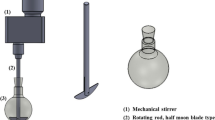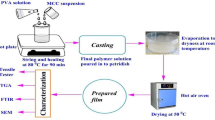Abstract
In this work, the optimization of synthesis of terpolymer monolith based on glycidyl methacrylate (GMA), ethylene glycol dimethacrylate (EGDMA) and additional cross-linkers: trimethylolpropanetriacrylate (TMPTA) or triethylene glycol dimethacrylate (TEGDMA) was performed. Moreover, novel vinyl functionalized cross-linkable polymers: ethanolamine (EA)/methacryloyl (MAC) modified poly (methyl methacrylate) (PMMA), and hydrolyzed poly (ethylene-co-vinyl acetate) copolymer (EVOH) modified with MAC either directly or via ethyl malonyl chloride/EA bridging group (m-EVA) were used as cross-linkable polymer to improve mechanical/elastic properties of the obtained monoliths. Optimization procedure, performed applying response surface methodology (RSM), was focused on the production of materials with improved dimensional stability/integrity and porosity with abundance of epoxide groups capable for immobilization of lipase from Candida rugosa (CRL). Structural characterization of the synthesized monoliths was determined using FTIR, Raman and 1H NMR spectroscopies, while morphology/porosity was determined by SEM technique and image analysis; and mechanical properties by diametral compression testing. The most potential monolith containing m-EVA polymeric cross-linker, i.e. GMA/EGDMA/TEGDMA/m-EVA monolith, was used as CRL carrier in a two-step immobilization process. Enzyme loading and the activity of obtained preparations for various initial enzyme concentrations were monitored after 4 and 48 h of immobilization. The resulting catalysts show high potency in biocatalytic reactions with the highest percentage of retained initial lipase activity of 64.5%.









Similar content being viewed by others
References
Thangaraj B, Solomon PR (2019) Immobilization of Lipases – A Review. Part I: Enzyme Immobilization. ChemBioEng Rev 6:157–166
Krajewska B (2004) Application of chitin- and chitosan-based materials for enzyme immobilizations: a review. Enzym Microb Technol 35:126–139
Cheng W, Li Y, Li X, Bai W, Liang Y (2019) Preparation and characterization of PDA/SiO2 nanofilm constructed macroporous monolith and its application in lipase immobilization. J Taiwan Inst Chem Eng 104:351–359
Sheldon RA (2007) Enzyme Immobilization: The Quest for Optimum Performance. Adv Synth Catal 349:1289–1307
Sharma S, Kanwar SS (2014). Sci World J Article ID:625258
Hsissou R, Bekhta A, Khudhair M, Berradi M, El-Aouni N, Elharfi A (2019). J Cheml Technol Metall 54:1128–1136
Zhou C, Li R, Luo W, Chen Y, Zou H, Liang M, Li Y (2016) The preparation and properties study of polydimethylsiloxane-based coatings modified by epoxy resin. J Polym Res 23:14
Matte CR, Bordinhão C, Poppe JK, Benvenutti EV, Costa TMH, Rodrigues RC, Hertza PF, Ayub MAZ (2017). J Braz Chem Soc 28:1430–1439
Vaidya BK, Ingavle GC, Ponrathnam S, Nene SN (2012) Poly(allyl glycidyl ether-co-ethylene glycol dimethacrylate) copolymer beads as support for covalent immobilization of l-aminoacylase. React Funct Polym 72:687–694
Banjanac K, Mihailović M, Prlainović N, Stojanović M, Carević M, Marinković A, Bezbradica D (2016) Cyanuric chloride functionalized silica nanoparticles for covalent immobilization of lipase. J Chem Technol Biotechnol 91:439–448
Palomo JM, Fernandez-Lorente G, Mateo C, Ortiz C, Fernandez-Lafuente R, Guisan JM (2002) Modulation of the enantioselectivity of lipases via controlled immobilization and medium engineering: hydrolytic resolution of mandelic acid esters. Enzym Microb Technol 31:775–783
Rahman A, Iqbal M, Rahman F, Fu D, Yaseen M, Lv Y, Omer M, Garver M, Yang L, Tan T (2012) Synthesis and characterization of reactive macroporous poly(glycidyl methacrylate-triallyl isocyanurate-ethylene glycol dimethacrylate) microspheres by suspension polymerization: Effect of synthesis variables on surface area and porosity. J Appl Polym Sci 124:915–926
Milosavić N, Prodanović R, Velićković D, Dimitrijević A (2017) Macroporous Poly(GMA-co-EGDMA) for Enzyme Stabilization. Methods Mol Biol 1504:139–147
Slabospitskaya MY, Vlakh EG, Saprykina NN, Tennikova TB (2008). J Appl Polym Sci 111:692–700
Bedair M, El Rassi Z (2005) Affinity chromatography with monolithic capillary columns. J Chromatogr A 1079:236–245
Rober M, Walter J, Vlakh E, Stahl F, Kasper C, Tennikova T (2009) New 3-D microarray platform based on macroporous polymer monoliths. Anal Chim Acta 644:95–103
Liu W, Duan H, Meng X, Qin D, Wang X, Zhang J (2013) Immobilization ofCandida lipolyticalipase on macroporous beaded terpolymers with epoxy groups. J Appl Polym Sci 127:4251–4255
Zhou X, Xue B, Sun Y (2001) Enhancing Protein Capacity of Rigid Macroporous Polymeric Adsorbent. Biotechnol Prog 17:1093–1098
Acquah C, Danquah MK, Moy CKS, Ongkudon CM (2016). J Appl Polym Sci 133:43507
Tambe SP, Singh SK, Patri M, Kumar D (2008) Ethylene vinyl acetate and ethylene vinyl alcohol copolymer for thermal spray coating application. Prog Org Coat 62:382–386
Vukoje I, Džunuzović E, Vodnik V, Dimitrijević S, Ahrenkiel P, Nedeljković J (2014) Synthesis, characterization, and antimicrobial activity of poly(GMA-co-EGDMA) polymer decorated with silver nanoparticles. J Mater Sci 49:6838–6844
Sontheimer H, Crittenden JC, Scott SR (1988) Activated carbon for water treatment. DVGW-Forschungsstelle, Engler-Bunte-Institut, Universitat Karlsruhe (TH), Germany, Karlsruhe
Banjanac K, Mihailović M, Prlainović N, Ćorović M, Carević M, Marinković A, Bezbradica D (2016) Epoxy-silanization - tool for improvement of silica nanoparticles as support for lipase immobilization with respect to esterification activity. J Chem Technol Biotechnol 91:2654–2663
Lowry OH, Rosebrough NJ, Farr AL, Randall RJ (1951) Protein measurement with the Folin phenol reagent. J Biol Chem 193:265–275
Bidsorkhi HC, Adelnia H, Heidar Pour R, Soheilmoghaddam M (2015) Preparation and characterization of ethylene-vinyl acetate/halloysite nanotube nanocomposites. J Mater Sc 50:3237–3245
Duan G, Zhang C, Li A, Yang X, Lu L, Wang X (2008) Preparation and Characterization of Mesoporous Zirconia Made by Using a Poly (methyl methacrylate) Template. Nanoscale Res Lett 3:118–122
Peike C, Phondongnok W, Kaltenbach T, Weiss K-A, Koehl M (2014). Open J Renew Energy Sustain Dev 1:14–21
Socrates G (2004). J Raman Spectrosc 35:905–905
Ketels HHT (1989) Synthesis, characterization and applications of ethylene vinylalcohol copolymers. PhD Thesis, Technische Universiteit Eindhoven, Eindhoven
Thomas KJ, Sheeba M, Nampoori VPN, Vallabhan CPG, Radhakrishnan P (2008) Raman spectra of polymethyl methacrylate optical fibres excited by a 532 nm diode pumped solid state laser. J Opt A Pure Appl Opt 10:055303
Tang M, Hou J, Lei L, Liu X, Guo S, Wang Z, Chen K (2010) Preparation, characterization and properties of partially hydrolyzed ethylene vinyl acetate copolymer films for controlled drug release. Int J Pharm 400:66–73
Abbate M, Martuscelli E, Musto P, Ragosta G, Scarinzi G (1994) Toughening of a highly cross-linked epoxy resin by reactive blending with bisphenol A polycarbonate. I. FTIR spectroscopy. J Polym Sci Part B Polym Phys 32:395–408
Chen Y, Xu G, Liu X, Pan Q, Zhang Y, Zeng D, Sun Y, Ke H, Cheng K (2018) A gel single ion conducting polymer electrolyte enables durable and safe lithium ion batteriesviagraft polymerization. RSC Adv 8:39967–39975
Zych A, Verdelli A, Soliman M, Pinalli R, Vachon J, Dalcanale E (2019) Polym. Chem 10:1741–1750
Liu G, Liu Z, Zou W, Li Z, Peng J, Cheng W, Xu S (2009). Acta Chim Slov 56:946–952
Taleb K, Markovski J, Milosavljević M, Marinović-Cincović M, Rusmirović J, Ristić M, Marinković A (2015) Chem Eng. J 279:66–78
Vukoje I, Džunuzović E, Lončarević D, Dimitrijević S, Ahrenkiel P, Nedeljković J (2017) Synthesis, characterization, and antimicrobial activity of silver nanoparticles on poly(GMA‐co‐EGDMA) polymer support. Polym Compos 38:1206–1214
Chaudhary V, Sharma S (2019) Suspension polymerization technique: parameters affecting polymer properties and application in oxidation reactions. J Polym Res 26:102
Nuraje N, Khan W, Lei Y, Ceylan M, Asmatulu R (2013) Superhydrophobic electrospun nanofibers. J Mater Chem A 1:1929–1946
Mateo C, Pessela BCC, Grazu V, Torres R, López-Gallego F, Guisan JM, Fernandez-Lafuente R (2001) One-step purification, covalent immobilization, and additional stabilization of poly-His-tagged proteins using novel heterofunctional chelate-epoxy supports. Biotechnol Bioeng 76:269–276
Natalello A, Ami D, Brocca S, Lotti M, Doglia SM (2005) Secondary structure, conformational stability and glycosylation of a recombinant Candida rugosa lipase studied by Fourier-transform infrared spectroscopy. Biochem J 385:511–517
Prlainovic N, Bezbradica D, Knezevic-Jugovic Z, Marinković A, Mijin D (2011) Immobilization of enzymes onto carbon nanotubes. Hem Ind 65:423–430
Rygula A, Majzner K, Marzec KM, Kaczor A, Pilarczyk M, Baranska M (2013) Raman spectroscopy of proteins: a review. J Raman Spectrosc 44:1061–1076
Maiti NC, Apetri MM, Zagorski MG, Carey PR, Anderson VE (2004) Raman Spectroscopic Characterization of Secondary Structure in Natively Unfolded Proteins: α-Synuclein. J Am Chem Soc 126:2399–2408
Orellana F, Lisperguer J (2011). J Chil Chem Soc 56:8–11
Soheilmoghaddam M, Wahit MU, Yussuf AA, Al-Saleh MA, Tuck Whye W (2014) Characterization of bio regenerated cellulose/sepiolite nanocomposite films prepared via ionic liquid. Polym Test 33:121–130
Kamal MZ, Yedavalli P, Deshmukh MV, Rao NM (2013) Lipase in aqueous-polar organic solvents: Activity, structure, and stability. Protein Sci 22:904–915
Hanefeld U, Gardossi L, Magner E (2009) Understanding enzyme immobilisation. Chem Soc Rev 38:453–468
Prlainović N, Knežević-Jugović Z, Mijin D, Bezbradica D (2011) Immobilization of lipase from Candida rugosa on Sepabeads®: the effect of lipase oxidation by periodates. Bioprocess Biosyst Eng 34:803–810
Bayramoǧlu G, Kaya B, Arica MY (2005) Immobilization of lipase onto spacer-arm attached poly(GMA-HEMA-EGDMA) microspheres. Food Chem 92:261–268
Huang XJ, Yu AG, Xu ZK (2008) Covalent immobilization of lipase from Candida rugosa onto poly(acrylonitrile-co-2-hydroxyethyl methacrylate) electrospun fibrous membranes for potential bioreactor application. Bioresour Technol 99:5459–5465
Acknowledgements
This work was supported by the Ministry of Education, Science and Technological Development of the Republic of Serbia (Contract No. 451-03-68/2020-14/200135 and 451-03-68/2020-14/200325).
Author information
Authors and Affiliations
Corresponding author
Additional information
Publisher’s note
Springer Nature remains neutral with regard to jurisdictional claims in published maps and institutional affiliations.
Electronic supplementary material
ESM 1
(DOCX 2289 kb)
Rights and permissions
About this article
Cite this article
Veličić, Z., Rusmirović, J., Prlainović, N. et al. The optimization of glycidyl methacrylate based terpolymer monolith synthesis: an effective Candida rugosa lipase immobilization support. J Polym Res 27, 127 (2020). https://doi.org/10.1007/s10965-020-02127-z
Received:
Accepted:
Published:
DOI: https://doi.org/10.1007/s10965-020-02127-z




